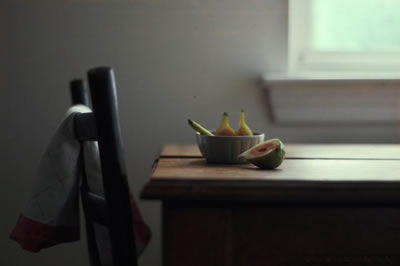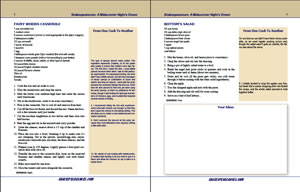A Midsummer Night's Dream
Bottom's Up
 Upon meeting the fairy Mustardseed, Bottom opines that "giantlike Oxbeef hath devoured many a gentleman of your house," and that he, too, has had many encounters with Mustardseed's "kindred" (III.1.151). It has to be a disconcerting moment for the fairy, this big beef of a man with an ass's head speaking of his love for mustard sauce. However, Bottom—in many ways the wisest of the play's characters (it is he, after all, who says "reason and love keep little company together nowadays" a few lines before meeting Mustardseed)—is recognizing something Shakespeare makes clear in his depiction of the fairies: that they comprise the elements of the Earth and are of the Earth's elements.
Upon meeting the fairy Mustardseed, Bottom opines that "giantlike Oxbeef hath devoured many a gentleman of your house," and that he, too, has had many encounters with Mustardseed's "kindred" (III.1.151). It has to be a disconcerting moment for the fairy, this big beef of a man with an ass's head speaking of his love for mustard sauce. However, Bottom—in many ways the wisest of the play's characters (it is he, after all, who says "reason and love keep little company together nowadays" a few lines before meeting Mustardseed)—is recognizing something Shakespeare makes clear in his depiction of the fairies: that they comprise the elements of the Earth and are of the Earth's elements.
It is a concept I have enfolded in my main course for this play, which represents the central setting of A Midsummer Night's Dream: the fairy wood outside Athens. My casserole features broccoli as the trees, rice as the undergrowth, mushrooms as the Earth, and onions as the underearth. It is shrouded with a fog (II.1.91) of three cheeses: feta to represent the play's Greek setting, Romano to represent the ancient world, and English cheddar to reflect the very English rude mechanicals. Mixed in are the four fairies called upon to serve Bottom: Mustardseed (literally), Peaseblossom (squash), Cobweb (represented as alfalfa sprouts), and Moth (vermouth: a stretch, I admit), along with a bit of curry powder to represent the fairy king and queen just arriving from the "farthest step of India" (II.1.70) and wrangling over the Indian changeling boy. The casserole uses a single egg as a bonding agent, and you could argue it's a Robin's egg, representing Puck. To give the plate color and contrast, I serve this casserole with slices of tomato.
The other dishes derive from direct references in the play. The starter is a treat for Bottom, who, as any ass would, likes apples (another apple reference: Oberon squeezes the love potion—the same that entranced Titania—into the "apple of [Demetrius's] eye" at III.2.104). Bottom himself sends Cobweb to get a honey bag (IV.1.10), and when Titania asks him what he'd like to dine on, he asks for provender, oats, and "good hay, sweet hay" (IV.1.25). Titania, of more refined taste than her lover, instead offers him "new nuts" (IV.1.26). My salad, then, is apples, nuts, and pasta hay mixed in a dressing of honey, olive oil, and lemon. The dessert is a treat built from Titania's command to her fairies to feed Bottom with "apricocks and dewberries, with purple grapes, green figs, and mulberries. The honey bags steal from the humble bees" (III.1.127). This forms the filling for filo-dough turnovers.
For my other meal, we present a breakfast to honor the fairies in one of their most important tasks—one they specifically use to consecrate the house of the three pairs of lovers (V.1.385)—and serve up morning dew on the forest floor: honeydew on a layer of lettuce topped with ginger whipped cream and a little fairy dust.
Eric Minton
February 26, 2015
FAIRY WOODS CASSEROLE
1 cup uncooked rice
1 medium onion
8 ounces mushrooms (crimini is most appropriate to the play's imagery)
3 tablespoons butter
1/2 cup vermouth
1 bunch of broccoli
1 zucchini
1 egg
3 tablespoons whole grain Dijon mustard (the kind with seeds)
1 teaspoon curry powder (mild or hot according to your tastes)
2 ounces of alfalfa, clover, radish, or other type of sprouts
1/4 pound feta cheese
1/4 pound English cheddar cheese
1/4 pound Romano cheese
Olive oil
Breadcrumbs
Tomato
- Cook the rice and set aside to cool.
- Slice the mushrooms and chop the onion.
- Melt the butter over medium-high heat and sauté the onions until translucent.
- Stir in the mushrooms, sauté to an even consistency.
- Pour in the vermouth. Stir to coat all and remove from heat.
- Cut off the broccoli florets and discard the rest. Steam the broccoli a few minutes until just tender.
- Cut the zucchini lengthwise in two halves and then slice into half-moons.
- Beat the egg and stir in the mustard and curry powder.
- Grate the cheeses, reserve about a 1/3 cup of the cheddar and Romano.
- Place the rice into a bowl, breaking it up to make sure it's not clumping. Stir in the sprouts, mustard-egg mix, onion-mushroom-vermouth mix, zucchini, the three cheeses, and the broccoli.
- Preheat oven to 350 degrees. Lightly grease a four-quart casserole dish with olive oil.
- Transfer the mix to the casserole dish, layer on the reserved Romano and cheddar cheese, and lightly coat with breadcrumbs.
- Bake uncovered for one hour.
- Slice the tomato and serve alongside the casserole.
Servings: Eight.
From one cook to another
- The type of sprouts doesn't really matter. This ingredient represents Cobweb, so it's the spider web quality it evokes that matters more than flavor. The first time I made this dish, I used alfalfa sprouts because that's what I saw at that particular supermarket. For subsequent testing, the store didn't have alfalfa sprouts, but did have packages of "zesty" sprouts (a combination of clover and radish) and broccoli sprouts. I went with the zesty because the casserole already has broccoli. At the time the dish passed its final test, we were using the zesty sprouts, so that's my preference for this recipe, though it was finding the right type and balance of cheeses, eggs, and mustard that required several rounds of testing.
- I recommend letting the rice and mushroom-onion-vermouth mixture cool enough so that they don't cause the cheese to melt during stirring. This will allow you to create a more balanced and consistent casserole.
- Don't overcook the broccoli when you are steaming them because they must withstand some vigorous stirring a little while later.
- Be careful of over-coating with breadcrumbs. A medium-light dusting is all you need to give it a flavor and allow the cheeses on top to bake to a toasty flavor.
BOTTOM'S SALAD
1/4 cup honey
1/4 cup extra virgin olive oil
2 tablespoons lemon juice
2 tablespoons fresh chives
4 ounces angel hair pasta
1 apple
1 cup walnut pieces
Leaf lettuce
- Mix the honey, olive oil, and lemon juice to consistency.
- Chop the chives and stir into the dressing.
- Bring a pot of lightly salted water to a boil.
- Break the angel hair pasta sticks in quarters and cook in the boiling water until al dente (about two minutes).
- Drain and let cool (if the pasta gets sticky, run cold water through it before mixing with the other salad ingredients).
- Chop the apple.
- Toss the chopped apple and nuts with the pasta.
- Add the dressing and stir well for even coating.
- Serve on a bed of leaf lettuce.
Servings: Four.
From one cook to another
- On one test run we didn't have fresh chives available, so we used regular cooking onions and, though the salad wasn't quite as colorful, the flavor was about the same.
- I initially tended to chop the apples very fine, but Sarah did a coarse chopping when she tested the recipe, and the whole salad seemed to hold together better.
TITANIA'S TURNOVERS
8 apricots (fresh or dried)
12 figs (fresh or dried)
1 stem of purple seedless grapes (about 20)
6 ounce package of dewberries (i.e., blackberries)
6 ounces of mulberries (if available; raspberries can be a substitute)
1/2 cup red wine, plus two tablespoons
2 tablespoons-plus honey
2 tablespoon arrowroot
3 tablespoons butter
Box of filo sheets (you'll need at least eight)
- Chop the apricots and figs.
- Cut the grapes in quarters.
- Mix all the fruit in a saucepan.
- Combine the half-cup red wine with 2 tablespoons of honey, mix well, and stir into the fruit.
- Cook covered over medium heat for 15 minutes.
- Stir the arrowroot into two tablespoons of wine; pour into the fruit mixture to thicken. You want a jam-like consistency.
- Remove from the heat.
- Preheat oven to 350 degrees.
- Melt the butter.
- Fold one sheet of filo dough into a square. Brush butter across the edges of the square, spoon some filling onto the middle, fold the square over to create a triangle. Press down the edges to seal.
- Repeat until you run out of filling, filo, or patience.
- Stir a little honey into the remaining butter and brush over the top of the turnovers.
- Bake at 350 degrees for 30 minutes.
Servings: Seven to eight turnovers of 4x4 squares.
MORNING DEW
1 honeydew melon
Leaf lettuce
1/2 pint whipping cream
1/2 teaspoon powdered ginger
Demerara sugar
- Remove the rind and chop the melon.
- Add the ginger to the cream and beat until you have stiff whipped cream.
- Lay the leaf lettuce in bowls, spoon the honeydew chunks on top, add a dollop of the ginger whipped cream, and sprinkle some Demerara sugar over the top.
Servings: Four.
Wine Pairing
For purposes both thematic and taste, a good Greek white is the way to go. We found the Zoe Tree of Life (60 percent Roditis, 40 percent Moscofilero) a perfect pairing for both the Bottom's Salad and the Fairy Woods Casserole—even had that wow! moment with the feta in the casserole. However, it falters with the turnovers. If you prefer red wines, try a Greek Saint George (Achiorghitiko). The Skouras Saint George is a bit tinny on its own, but it is an adequate match with the salad and main course and offers a lovely pairing with the Titania Turnover. If you can't find a good Greek white, an alternative is a French Viognier (a Terroirs du Vent La Violette from Pays d'Oc was a delightful accompaniment), and another red option is a Malbec from Argentina: it matches up to the broccoli /cheese/mushroom flavors in the main course, and though it way overpowers the Bottom's Salad, the Trivento Reserve is a perfect pairing with Titania's Turnovers.
Comment: e-mail editorial@shakespeareances.com




 Find additional Shakespeareances
Find additional Shakespeareances